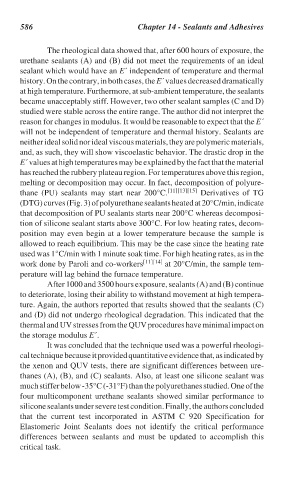Page 618 - Handbook of Thermal Analysis of Construction Materials
P. 618
586 Chapter 14 - Sealants and Adhesives
The rheological data showed that, after 600 hours of exposure, the
urethane sealants (A) and (B) did not meet the requirements of an ideal
sealant which would have an E´ independent of temperature and thermal
history. On the contrary, in both cases, the E´ values decreased dramatically
at high temperature. Furthermore, at sub-ambient temperature, the sealants
became unacceptably stiff. However, two other sealant samples (C and D)
studied were stable across the entire range. The author did not interpret the
reason for changes in modulus. It would be reasonable to expect that the E´
will not be independent of temperature and thermal history. Sealants are
neither ideal solid nor ideal viscous materials, they are polymeric materials,
and, as such, they will show viscoelastic behavior. The drastic drop in the
E´ values at high temperatures may be explained by the fact that the material
has reached the rubbery plateau region. For temperatures above this region,
melting or decomposition may occur. In fact, decomposition of polyure-
thane (PU) sealants may start near 200°C. [11][13][15] Derivatives of TG
(DTG) curves (Fig. 3) of polyurethane sealants heated at 20°C/min, indicate
that decomposition of PU sealants starts near 200°C whereas decomposi-
tion of silicone sealant starts above 300°C. For low heating rates, decom-
position may even begin at a lower temperature because the sample is
allowed to reach equilibrium. This may be the case since the heating rate
used was 1°C/min with 1 minute soak time. For high heating rates, as in the
work done by Paroli and co-workers [11][14] at 20°C/min, the sample tem-
perature will lag behind the furnace temperature.
After 1000 and 3500 hours exposure, sealants (A) and (B) continue
to deteriorate, losing their ability to withstand movement at high tempera-
ture. Again, the authors reported that results showed that the sealants (C)
and (D) did not undergo rheological degradation. This indicated that the
thermal and UV stresses from the QUV procedures have minimal impact on
the storage modulus E´.
It was concluded that the technique used was a powerful rheologi-
cal technique because it provided quantitative evidence that, as indicated by
the xenon and QUV tests, there are significant differences between ure-
thanes (A), (B), and (C) sealants. Also, at least one silicone sealant was
much stiffer below -35°C (-31°F) than the polyurethanes studied. One of the
four multicomponent urethane sealants showed similar performance to
silicone sealants under severe test condition. Finally, the authors concluded
that the current test incorporated in ASTM C 920 Specification for
Elastomeric Joint Sealants does not identify the critical performance
differences between sealants and must be updated to accomplish this
critical task.

